#lines & bogdanovich
Explore tagged Tumblr posts
Text
tuesday again 2/14/23
oops! all friend recs edition. this post brought to you by viewers like you. thank you!
listening
green day's last ride in, courtesy of @dying-suffering-french-stalkers. this DOES belong on a daisuke jigen lupinthethird playlist ur correct. not quote four minutes of a laid back, surf rock instrumental. above all this is the american genre of music that Wants you to think it sounds effortlessly cool, and jigen is one of very few fictional characters who puts that much work into looking effortlessly cool.
youtube
ran across some apocryphal reddit posts that are like "yeah they came up with this riff during a sound check and liked it so much they decided it didn't need lyrics". sure i'll buy that!
-
reading
The Skylark of Space by E.E. "Doc" Smith, courtesy of @believerindaydreams. restarting this audiobook available through my library, which is apparently the 1946 hardcover edition that differs wildly from editions before and after. what are those differences? who can say! i cannot easily find a breakdown!
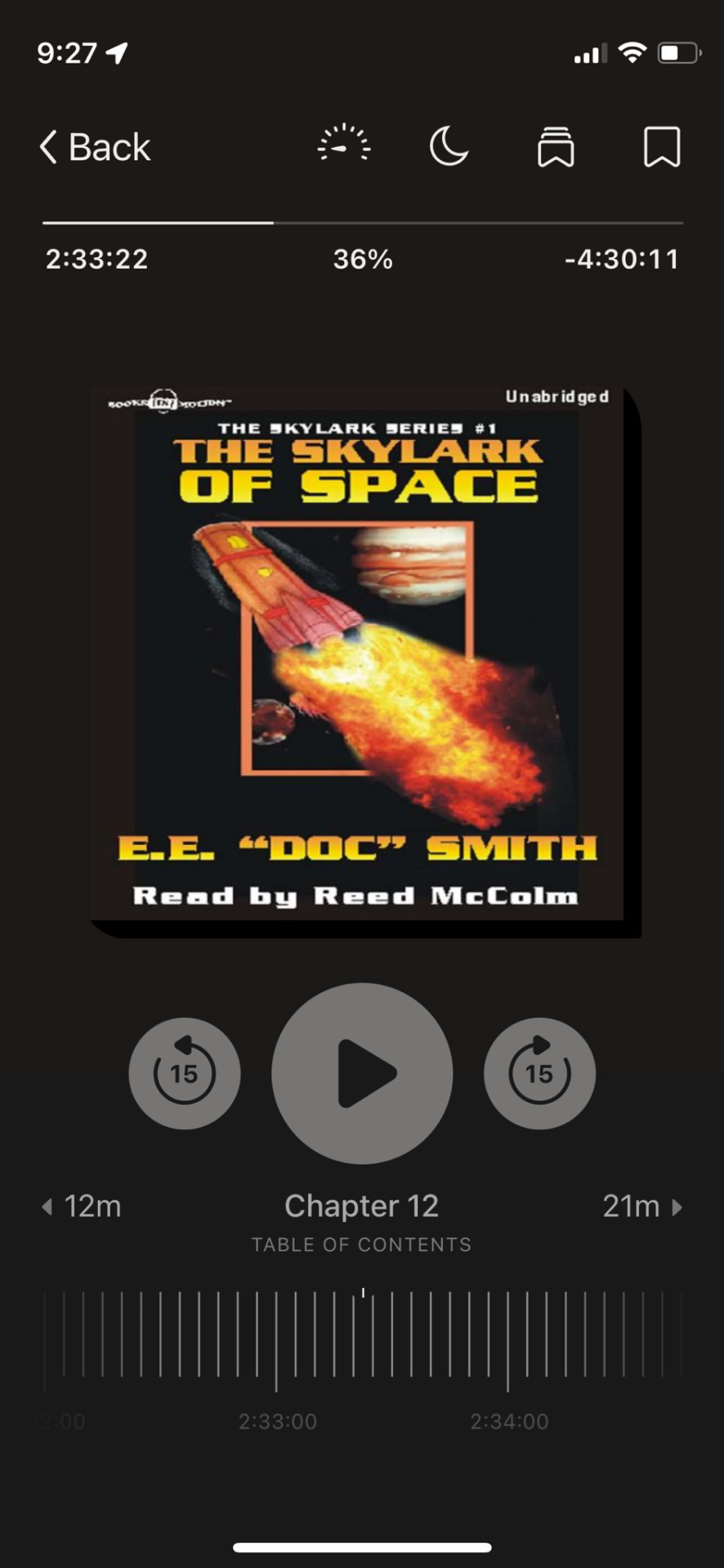
critical reception of this book was mixed. i think the criticisms about scientific plausibility (even by 1919 standards) and dialogue are warranted. doc smith was a chemical engineer, who are certainly. types of guys. most of the fun of this book (for me) comes in recognizing the building blocks of the space opera. i like peeling up the seams and following this novel's construction decisions. i don't fully agree that this is where space operas started, but arguments about how it's the most imitated space opera are convincing.
it's quite rare i listen to an audiobook bc my ears are not friends with my brain, and it's easier to listen to chattier podcasts where if i tune out for a moment i don't miss much. the reader? performer? reed mccolm has a voice i do better with (neutral american accent in the baritenor range). i don't really know if i'd find the paper version easier or harder to follow, bc mr mccolm is doing his absolute fucking best with the voicework but doc smith does not seem overly fond of dialogue tags. it is occasionally difficult to figure out who's speaking.
a line that made me stop folding laundry and yell HELLO??? out loud: "Each girl looked at the other, and liked what she saw." unfortunately no gay shit seems to be going on, but we spend a fuck of a lot of time in this chapter going over how the spaceship works, so it's very possible they're engaging in quiet bisexualism in the background and doc smith has simply not noticed. gay shit going on in the background is not critical to our understanding of how the spaceship works.
-
watching
What's Up Doc? (1972, dir. Bogdanovich) courtesy of @nikkifromtabs. i had a fucking marvelous time with this screwball comedy. i could not give you any of the finer details of the plot or who has what bag when but i enjoyed every goddamn minute. as i write this on monday night it is singlehandedly responsible for improving a miserable day. MANY short sharp barks of laughter

i love screwballs but they tend to stress me the fuck out-- bringing up baby is verging on a horror movie for me. even though streisand's character would be the very best of friends with hepburn's character in bringing up baby, this movies stresses me the fuck out WAY less. perhaps its bc it feels more like a stage play, or more deliberately humorous, or just that the stakes feel way lower. the mile a minute dialogue is best appreciated with subtitles
youtube
can we go back to the halycon days when dudes were not waxed bare and dangerously dehydrated in order to have a shirtless scene? ryan o'neal is a handsome if slightly bland man and he looks like Just Some Guy with his shirt off. great! love it! give me more!
i was going to write a whole little thing about "everyone is beautiful and no one is horny" but we can boil it down to "seventies beauty standards are wildly different from today's" and "everyone in this movie is almost always too busy sliding in and out of various scrapes to be horny"
kung fu hustle, arsenic & old lace, and this movie are now in a three-way tie for my favorite comedy.
-
playing
Dead Man's Rest courtesy of @jaimehwatson who recced this nearly three years ago and @pasta-pardner who gifted it to me last week. i have played it for three hours got three different routes and none of them are "happy". are any of them happy? is this a commentary on the inherent tragedy of revenge and the inherent tragedy of the american western, never able to escape stolen dreams on stolen land? the tyranny of the small business/farm owner only able to exist on a mountain of skeletons and heavy subsidies from the government? i am rotating this game in my mind at helicopter speeds.
also chase i agree with you this sheriff is definitely supposed to be lee van cleef
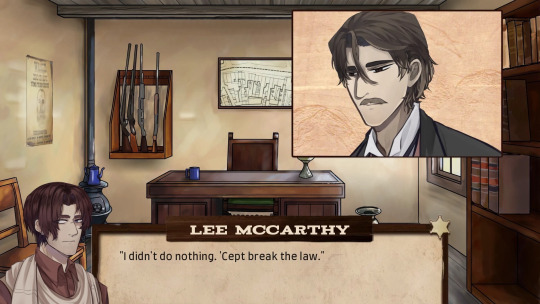
storytelling: it is uneven at best. the native american love interest's route is a particular weakness. as a review on steam said, it reads very much like the only media the devs consumed researching this was disney's pocahontas. there are some very moralistic and defensive statements throughout other routes as well that read like the devs trying to get ahead of any accusations, which makes this game much weaker as now it is neither a product of its time or ours. the mystery does unfold in a way that surprised me, and you have to go through multiple different routes with multiple people in order to get more of the solution. this is very hard to pull off and i liked this murder mystery/tragedy aspect of the game very much. i am not a mlm so i can't really comment on whether or not these romances are fulfilling, although they are straight up gay and there isn't a bisexual reading that can be applied. i, noted bisexual cowboy enjoyer, was a little disappointed that the MC cannot have a bisexual reading applied to him, he does seem very firmly at one end of the kinsey scale.
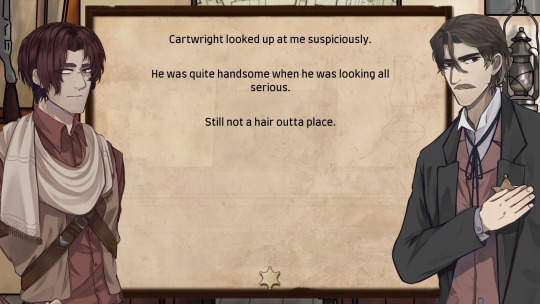
construction: there are four different ways of presenting dialogue. there are SO many routes in this thing and i feel like standardizing the text boxes would have made their lives easier? i do appreciate the vibes-based subtitles for the music and sfx. this is startlingly good caption work for a tiny idie studio.







is it "good"? did i have a "good time" playing it? fuck if i know. compels me tho.
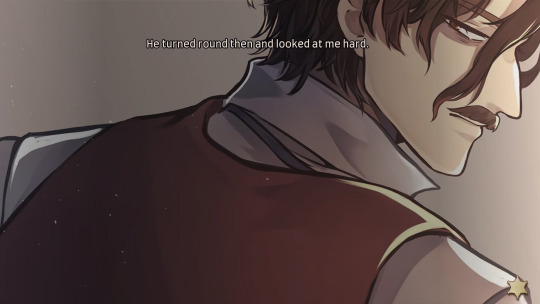
-
making
this one is For a friend but it fits the theme. baby blanket progress, about a repeat and a half in. the tentative baby date is march 5th and the tentative blanket date is uhhh probably end of may? at this pace?

#i don't usually have a schtick for these except for the one nearest star wars day but valentines on a tuesday was too cute to ignore#tuesday again#tuesday again no problem
21 notes
·
View notes
Text
The Best Picture Oscar My Way (1951-1979)
Here is Part 3 of my “Best Picture My Way” series. The last two are found here. My stipulations can be found in Part 1.
For convenience sake, I’ll relay this message. For Best Picture, I’m only gonna list the nominated producer for newly added films (here’s the Wikipedia page for the rest). I will mostly go with the ones credited as “produced by” or “p.g.a.” (if the latter is shown) on IMDB as the nominees. Limit is five.
Also, if you’re wondering why there are more years listed here than the other two, that’ll be answered in the next part.
1951
Rashomon - Minoru Jingo
Ace in the Hole - Billy Wilder
A Place in the Sun
Strangers on a Train - Alfred Hitchcock
A Street Called Desire
1952
High Noon
Forbidden Games - Robert Dorfmann
Singing in the Rain - Arthur Freed
Moulin Rogue
The Quiet Man
1953
Roman Holiday
From Here to Eternity
Shane
The Big Heat - Robert Arthur
The Stalag 17 - Billy Wilder
1954
On the Waterfront (still)
Rear Window - Alfred Hitchcock
The Caine Mutiny
Dial M for Murder - Alfred Hitchcock
Johnny Guitar - Nicholas Ray
1955
Marty (still)
The Night of the Hunter - Paul Gregory
Rebel Without a Cause - David Weisbart
The Long Grey Line - Robert Arthur
Mister Roberts
1956
Tea and Sympathy - Pandro S. Berman
The Ten Commandments
Giant
The Killing - James B. Harris
The Searchers - Patrick Ford
1957
The Bridge on the River Kwai (still)
12 Angry Men
Nights of Cabiria - Dino De Laurentiis
Witness for the Persecution
The Seventh Seal - Allan Ekelund
1958
Vertigo - Alfred Hitchcock
Mon Oncle - Jacques Tati
Touch of Evil - Albert Zugsmith
Auntie Mame
The Defiant Ones
1959
Ben-Hur (still)
Anatomy of a Murder
North by Northwest - Alfred Hitchcock
Some Like It Hot - Billy Wilder
The Diary of Anne Frank
1960
The Apartment (still)
Psycho - Alfred Hitchcock
Elmer Gantry
The Magnificent Seven - John Sturges
The Alamo
1961
West Side Story (still)
Through a Glass Darkly - Allan Ekelund
The Hustler
Judgment at Nuremberg
Breakfast at Tiffany’s - Martin; Jurow; Richard Shepherd
1962
Lawrence of Arabia (still)
To Kill a Mockingbird
Mutiny on the Bounty
The Man Who Shot Liberty Valance - Willis Goldbeck
The Longest Day
1963
8 1/2 - Angelo Rizzoli
The Great Escape - John Sturges
Lillies of the Field
America, America
Cleopatra
1964
Mary Poppins
Dr. Strangelove
My Fair Lady
The Umbrellas of Cherbourg - Mag Bodard
Woman in the Dunes - Kiichi Ichikawa; Tadashi Ono
1965
The Sound of Music (still)
Doctor Zhivago
A Patch of Blue - Pandro S. Berman; Guy Green
Darling
Ship of Fools
1966
Who’s Afraid of Virginia Woof?
A Man for All Seasons
The Professionals - Richard Brooks
The Sand Pebbles
A Man and A Woman - Claude Lelouch
1967
Persona - Ingmar Bergman
The Graduate
The Jungle Book - Walt Disney
In The Heat of the Night
Guess Who’s Coming to Dinner
1968
2001: A Space Odyssey - Stanley Kubrick
Oliver!
Funny Girl
The Lion in Winter
Rosemary’s Baby - William Castle
1969
Midnight Cowboy (still)
Butch Cassidy and the Sundance Kid
Z
The Wild Bunch - Phil Feldman
Easy Rider - Peter Fonda
1970
Patton (still)
M*A*S*H
Five Easy Pieces
Love Story
Investigation of a Citizen Above Suspicion - Marina Cicogna; Daniele Senatore
1971
The French Connection (still)
The Last Picture Show
McCabe & Mrs. Miller - Mitchell Brower; David Foster
A Clockwork Orange
Fiddler on the Roof
1972
The Godfather (still)
The Emigrants
Cabaret
The Heartbreak Kid - Edgar J. Scherick
The Discreet Charm of the Bourgeoisie - Serge Silberman
1973
Cries and Whispers
The Sting
The Exorcist
American Graffiti
Paper Moon - Peter Bogdanovich
1974
The Godfather Part II (still)
A Woman Under the Influence - Sam Shaw
Chinatown
The Conversation
Blazing Saddles - Michael Hertzberg
1975 (kept the same)
One Flew Over The Cuckoo’s Nest (still)
Barry Lyndon
Dog Dag Afternoon
Jaws
Nashville
1976
Rocky (still)
Taxi Driver
Network
Mikey and Nicky - Michael Hausman
All the President’s Men
1977
Annie Hall (still)
Star Wars
The Goodbye Girl
Eraserhead - David Lynch
3 Women - Robert Altman
1978
The Deer Hunter (still)
Heaven Can Wait
Midnight Express
Days of Heaven - Bart Schneider; Harold Schneider
Dawn of the Dead - Richard P. Rubinstein
1979
Apocalypse Now
All That Jazz
Manhattan - Charles H. Joffe
Alien - Gordon Carroll; David Giler; Walter Hill
Kramer vs. Kramer
#cinema#movies#film#academy award#oscars#alfred hitchcock#francis ford coppola#ingmar bergman#alternative#david lean#stanley kubrick#mary poppins#the godfather#2001: a space odyssey#billy wilder
5 notes
·
View notes
Text
3 notes
·
View notes
Text
That's All, Folks

Pre-Palaeozoic musical rocks, Barbara Streisand’s underwear, an offensive number of diamonds and top-secret documents are the product of a meticulous and generous game of “yes, and”. So it only makes sense that the accidental mixup of four identical red-and-blue plaid travel bags makes for the comedic climax of Peter Bogdanovich’s 1972 screwball comedy What’s Up, Doc?. Known for its fast-paced witty dialogue, a reversal of traditional gender roles and erratic plot lines, the screwball comedy offers space for the woman to be an active agent in the narrative. Streisand’s character Judy Maxwell moves the plot forward.
The screwball comedy gained popularity in 1930s and 1940s Hollywood, after the implementation of the Hays Code, when strict limitations were placed on depictions or suggestions of sex and nudity, profanity and violence in films. However in 1968, the Hays Code was abolished and replaced with an age based rating system that is still in place today. Released in 1972, Bogdanovich was not met with these limitations, but still largely kept to the traditional characteristics of this genre. What’s Up, Doc?, is an homage to the classic screwball comedies of the Golden Age of Hollywood.
In a time where women were not always afforded the luxury of choice and impropriety, Judy’s character is radical. At the start of the film, we watch as Judy checks into a hotel, only to be told that there is no reservation for her room - room 1717. The audience quickly realises that this was intentional, she didn’t have a reservation to begin with. Her crafty and frugal nature is revealed as the camera pans to her on the telephone ordering an excessive amount of food for room service to room 1717, and to leave it in the hall without knocking so as to wake her “little one”. We as the audience begin to understand - and fall in love with - this throw-away-the-rule-book character.
Her determination to go after her heart’s desires and her disregard for others and the rules is further shown in the scene where she meets Howard Bannister (Ryan O’Neal), the “square” musicology professor. Standing on opposite sides of the gift shop shelves, Howard picks up a souvenir rock embellished with “Alcatraz”, revealing Judy staring lovingly at him from the other side. As Howard pulls out his tuning fork to test the tonal qualities of the souvenir (because that’s what we all expected him to do), she delivers the titular line “what's up, doc?”, taking a bite of her carrot. He explains his rather ridiculous theory on “early man's musical relationship to igneous rock formations”, but this doesn’t throw Judy. She responds without hesitation (as if he were asking about the weather) with her preference for the “metamorphic or sedimentary rock categories” in fast-paced delivery all while she chomps down on her carrot stick. This is just one of many instances where the rapid dialogue demonstrates Judy’s quick wit and ingenuity.
At times it feels like Judy is the only one who gets the joke, making her all the more intriguing and enticing as a character. We hang onto her every word as she talks circles around everyone until they are left confused and you are left confused - but certain that she must be right. Howard’s absent-mindedness is the perfect match for her word-smithing. She inserts herself into his life before he even realises she’s there, let alone what she has done.
And just like her conversations, the film takes you on a journey. From hotel room mixups, a twenty-minute-long car chase (involving a delivery bike, and a “just married” VW Bug), to an incredibly vague courtroom explanation, the film’s erratic plot line is exemplary of the screwball comedy. The climax of the film begins with the accidental switcheroos of the four identical red-and-blue plaid travel bags. One belongs to Judy and contains her clothes and toiletries, the other has Howard’s musical rocks, the third is full of the jewels of a wealthy older woman and the fourth contains top-secret documents. The hotel receptionist and his lackey want to steal the jewels, while a golf-club-toting undercover agent is after the documents, and no one cares or wants the clothes or rocks. Each thief has stolen a bag but no one has the correct one. In an attempt to escape the fight that breaks out upon this discovery, Judy and Howard sneak out with all four bags, beginning one of the most ridiculous car chase scenes ever captured on film. Costume changes, car crashes, wet concrete and stolen vehicles all of which are accidentally launched off a pier into the bay. In the scene that follows, all parties involved argue at the courthouse as the charges are laid against them (including unauthorised use of public waters, grand larceny, assault with a deadly weapon, breaking and entering and kidnapping) and Howard attempts - in the most incoherent fashion - to explain the chain of events that led them to the present.
In the end, Judy gets the guy, her persistent fast-talking and daffy character having paid off to win over the absent-minded professor. Judy is presumptuous and careless, destructive and audacious, but also clever and facetious, bringing light into some people’s lives. She is a menace. But these quick-witted characters, the overlapping dialogue and bizarre events create for an incredibly eccentric film that evokes the tropes of the classic screwball comedy. At its heart, this film is a story of romance and attraction. (And rocks).
2 notes
·
View notes
Text
There’s this poem “Душенька” (Which should be translated as “Psyche” but actually sounds like “Sweetheart”) by Bogdanovich which has a line: “You’re pretty, Sweetheart, in every kind of clothes”. This is what comes to my mind as I see such posts. How can he be so ridiculous and gorgeous at the same time?? <3
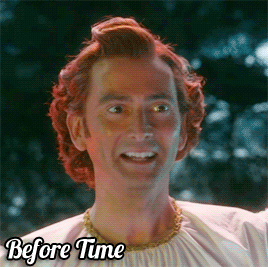



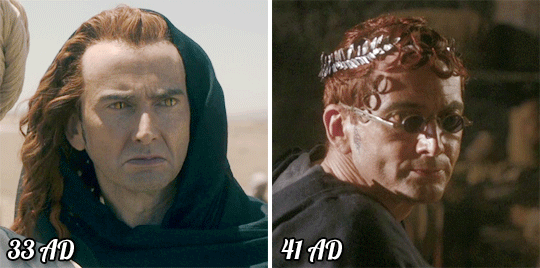

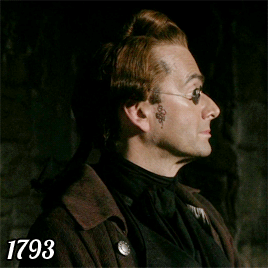
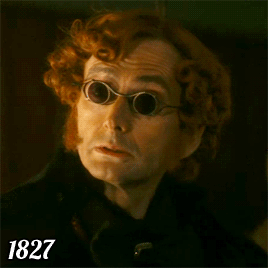

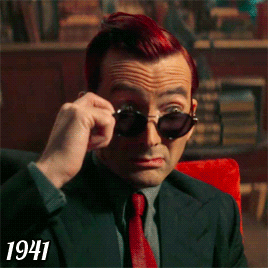
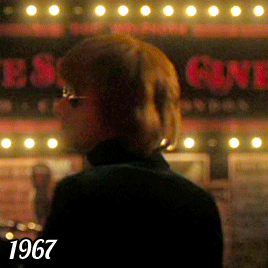


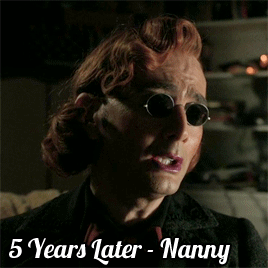

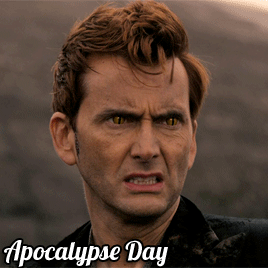
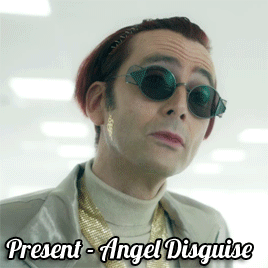
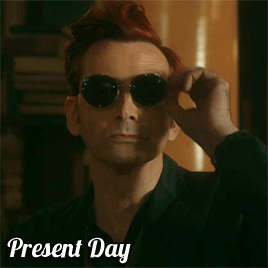
Crowley’s hairstyles/looks - down through the ages ...now including Good Omens Season Two
The original Season One post [ x ]
44K notes
·
View notes
Text
Targets



Made before director-co-writer Peter Bogdanovich knew what he couldn’t do, TARGETS (1968, Criterion) is one of the screen’s most audacious directorial debuts. As good as some of his work is, I’m tempted to call it Bogdanovich’s best film. And it certainly gave Boris Karloff one of the best roles of his career, essentially playing a variation on himself.
The film opens with the finale (almost) of one of Roger Corman’s most delirious films, THE TERROR (1963), which starred Karloff and the largely unknown Jack Nicholson. It then cuts to a screening room, where Karloff’s Byron Orloff has been unhappily watching the last of three low-budget horror films he’s just made. He informs his ambitious young director-writer (Bogdanovich) that he’s retiring without having read the young man’s new script, which you may suspect is the script for this film. The argument moves to the street, and suddenly we cut to Karloff seen through the sights of a sniper rifle. That moves us into the parallel story of Bobby Thompson (Tim O’Kelly), who’s stockpiling weapons for a killing spree. Bogdanovich switches between these stories almost effortlessly with the help of editor Verna Fields. The idea of the classic horror star who feels he’s no longer relevant in a world of real-life horrors like those perpetrated by O’Kelly may be a little too pat, and the inevitable merging of the two plots a little too convenient, but the ideas behind all this trump any objections.
Karloff is magnificent, giving a performance even more impressive when you know that between scenes he had to return to a wheelchair and breathe through an oxygen mask. He’s a master of subtlety. He never wastes a gesture, and he doesn’t just speak his lines; he makes love to them. O’Kelly is also strong, projecting a lot through long silent stretches. Bogdanovich wisely never explains the specifics that led him to mass murder (there’s a sense that he has father issues), but you get the impression that he and O’Kelly know exactly what’s going on in the character’s mind. Laszlo Kovacs did the pristine cinematography, with subtle camera moves to disguise the cutting and build tension. Bogdanovich’s then wife, Polly Platt, co-wrote the original story (there were uncredited writing assists from Sam Fuller) and did a terrific job designing the sets. Thompson lives with the family, and their home is a fascinating combination of story book setting and sterility. It’s the middle-class dream moldering around the edges.
#peter bogdanovich#boris karloff#laszlo kovacs#verna field#polly platt#horror film#mass murder#jack nicholson#cult movies
0 notes
Text
there's this one episode of himym where ted goes to a party full of 'pretentious' people, and peter bogdanovich is in it and has this line about cahiers du cinema and film being an auteur's medium...i understood it, am i too pretentious
#mine#to be fair i think most people are familiar with french new wave#if he had talked about bela balazs maybe it would have really gone over people's heads
0 notes
Text

Movie number 51: The Hatton Garden Job aka One Last Heist (Ronnie Thompson, 2016). Proving that coming first doesn’t always make you a winner, The Hatton Garden Job, like last year’s King of Thieves (James Marsh, 2018), is based upon the true story of the Hatton Garden safe burglary of 2015. Arriving in cinemas a full 17 months before King of Thieves this bungled bank job of a movie is weaker than its competitor in every department.
While purportedly based on the actual crime, this version of events is largely fictionalised. The basic plot of a bunch of ageing criminals conniving to pull off one last job is the same, yet the involvement of the Hungarian Mafia and a corrupt ex-copper are entirely fabricated. This would perhaps be forgivable if the retelling had any entertainment value. How such an audacious real life story can be transformed into such a dull and insipid movie is anybody’s guess.
Matthew Goode, Larry Lamb, Phil Daniels and Joley Richardson prop up the otherwise less than stellar cast but are severely let down by stilted dialogue and lazy character development. The screenplay by Ray Bogdanovich and Dean Lines fails to draw upon the inherent humour of the situations while Ronnie Thompson’s bland direction is lacking style and imagination.
If you like geezer ladden crime movies that take themselves too seriously then maybe The Hatton Garden Job is for you. Otherwise you would be better off checking out the superior King of Thieves. #thehattongardenjob #onelastheist #ronniethompson #raybogdanovich #deanlines #matthewgoode #larrylamb #phildaniels #joleyrichardson #kingofthieves #hattongarden #london #britishfilm #britishcinema #everymovieiwatch2019
#the hatton garden job#one last heist#ronnie thompson#ray bogdanovich#dean lines#matthew goode#larry lamb#phil daniels#joley richardson#king of thieves#hatton garden#london#british film#british cinema#every movie i watch 2019
3 notes
·
View notes
Photo

Cybill Shepherd in: The Last Picture Show (Dir. Peter Bogdanovich,1971). Source
94 notes
·
View notes
Text
Hounded
Throwing subtlety aside, Hounded is a straight-up lampoon of the kind of snooty toffs that believe the world is their birthright.
People have been intrigued by the concept of humans hunting humans ever since Richard Connell published his influential short story, “The Most Dangerous Game”, in 1924. Almost every iteration of the media it inspired over the last 100 years has carried through an element of class disparity between hunter and prey, used originally to highlight the barbarity of hunting animals. Hounded is the…

View On WordPress
#Comedy#Dean Lines#Hannah Traylen#Horror#James Lance#Malachi Pullar-Latchman#Ray Bogdanovich#Ross Coles#Samantha Bond#Satire#Survival Horror#Tommy Boulding
0 notes
Text

By John Katsilometes
Saturday, March 19, 2016
JERRY LEWIS 90TH BIRTHDAY PARTY
Throughout the day Wednesday, Jerry Lewis was wondering if anything was being planned for his 90th birthday. He was asking his family such cryptic questions as, “Are we doing anything tonight?”
Of course.
Lewis was given a surprise wingding at a favorite Las Vegas haunt, Piero’s Italian Restaurant, a fete bestowed by restaurant owner and longtime friend Freddie Glusman. About 30 members of Lewis’ family and assorted friends turned out for a grand night of dinner, drinks, laughs and — of course — a cake. Lewis was led to a private dining room at the back of the restaurant, where a debate ensued about how to behave during the legend’s entrance. “Turn off the lights and shut up!” was the directive of Claudia Stabile Marghilano, wife of master guitarist Joe Lano and whose late husband, Joe Stabile, was Lewis’ manager for nearly 60 years.
“Why?” called out Steve Lawrence, seated next to Glusman at the head of the table. “He can’t hear, and he can’t see!”
The debate went dark, and Lewis arrived with his wife, Sam, as the room erupted. Lewis’ daughter Danielle warmly said to her father, “Thank you for being my best friend.” Glusman soon stood to thank Lewis for his lifetime of friendship, remembering that Piero’s was given a huge boost when Lewis mentioned the restaurant during the MDA Labor Day Telethon broadcasts. “There are two Jerry’s who made Piero’s a success,” Glusman said. “Jerry Lewis and Jerry Tarkanian.”
A video of celebs was played for the group, a clip full of messages from an array of stars including Al Pacino, Don Rickles, Jennifer Lopez, John Travolta, Celine Dion, Peter Bogdanovich, Criss Angel, Carl Reiner, Nicolas Cage, Tony Orlando, Chris Meloni, Woody Harrelson and agent Jeff Witjas. Rickles, who turns 90 on May 8, closed the video with, “Happy Birthday. Now go to the doctor!”
Adding to the well-wishers was Wayne Newton, who sent a note of congratulations during the party. In the group of invitees was comic Dane Cook, who in 2011 met Lewis at the Los Angeles premiere of the documentary “Method to the Madness of Jerry Lewis.” “Ever since, we’ve become great friends,” Cook said during dinner. “We just call each other randomly to talk.” The requisite cake presentation was a two-pronged affair. We had the traditional blowing of the candles, but before that an oversized cake was brought to the room by Danielle.
“I know somebody is in there!” Lewis laughed, as the costume disassembled to present Melody Sweets of “Absinthe” singing a sultry “Happy Birthday,” toying with Lewis and Glusman during the number. Afterward, Lawrence seized the cake top and brought it to Lewis, saying, “Here, you might want this later.” We did hear from the man of the moment, who set down his wine and took the mic.
“I want to say that I am so delighted to make 90 and to have all of my friends here,” Lewis said, his voice wavering. “It’s such a lovely, wonderful, exciting thing for me. I’m so proud … so grateful, and I can’t really explain the feeling of seeing all these faces that have made my life wonderful. Thank you.”
That soft and simple message deserved a round of applause and a long line of hugs. Jerry Lewis got all of that, too.
#i feel like crying#he was so full of energy#he no longer saw#no longer walked#no longer heard#yet he was still so tenaciously clinging to Life!#as a child ... he wanted the party in his honor ❤️#this man for me is a great example of life#jerry lewis
7 notes
·
View notes
Photo

The Banishing has been released on Blu-ray and DVD today via RLJE Films. The 2020 British horror film is streaming exclusively on Shudder.
Based on a true story, the film is directed by Christopher Smith (Triangle, Black Death) and written by David Beton, Ray Bogdanovich, & Dean Lines (The Hatton Garden Job). Jessica Brown Findlay, John Heffernan, John Lynch, and Sean Harris star.
No special features are listed. Read on for the trailer and synopsis.
youtube
A young reverend, his wife and daughter move into a manor with a horrifying secret. When a vengeful spirit haunts the little girl and threatens to tear the family apart, the reverend and his wife are forced to confront their beliefs. They must turn to black magic by seeking the help of a famous Occultist...or risk losing their daughter.
Pre-order The Banishing.
#the banishing#horror#christopher smith#jessica brown findlay#john lynch#sean harris#john heffernan#shudder#dvd#gift#horror movies#horror film#british horror#british film#based on a true story
13 notes
·
View notes
Text
Audrey (2020) - review

Helena Jean Coan’s Audrey premiered on Netflix this Sunday, March 14, and I finally had a chance to sit down and watch it. The documentary was described as a definitive source, showing the true Audrey who was hidden behind the glamour and Hollywood allure. It is required viewing for anyone who is unaware of the real Audrey Hepburn. But for her devoted fans, it is a love letter.
Audrey provides a wealth of information about the three distinct stages of her life: childhood, career, and humanitarian work. Although each could be a full biography on their own, the documentary does not bombard the viewer with information. Kudos must be given to Coan and her crew for the seamless way each period of life unfolds on film. What makes it especially valuable is Audrey’s own voice telling her story. Her family and friends also appear, and there’s new home movie footage as well.
Film historian Molly Haskell, director Peter Bogdanovich, who directed Audrey in They All Laughed (1980) and her costar in the 1989 film Always, Richard Dreyfuss, provide context on her place in Hollywood. Haskell recalls how Audrey’s role in Roman Holiday resonated with her: she absconded from being a princess, a role Haskell herself never wanted to play. Haskell also refers to Princess Ann in that film as willfully self liberated.
“That she was called an artist of love, I think, is truly fitting.”
Molly Haskell
Breakfast at Tiffany’s, arguably Audrey’s best known film, warrants greater attention than the rest, but this is done modestly. Audrey herself was uncomfortable with how ubiquitous Holly Golightly was, but it does contain one of her best performances, a sentiment echoed by Haskell and Bogdanovich.
It’s not only photographs, film scenes, or talking heads in the documentary, but dancers portraying Audrey in wordless segments. This elevates the film by centering Audrey’s first great love of dance, and lends it all the poetry of motion. A story is being told, from young Audrey watching her father leave, to older Audrey accepting herself with serenity.
People often take Audrey for granted, or complain that she’s everywhere. And honestly, her image has been commodified to such an extent that it’s easy to assume she was merely a glamorous star. But as numerous biographies and this documentary attest, she was so much more, and she deserves to be remembered and loved. Celebrity culture is damaging, but she was born to be a star, and she is worth emulating.
Audrey suffered greatly in her life. From her parents’ divorce and the abandonment by her father, who she didn’t see again until she tracked him down as an adult; the second world war and the terror of the Nazis; her miscarriages; her own divorces; and the cancer that claimed her life. The documentary covers all of this ground but never in a pitying way. Audrey herself didn’t indulge in self-pity. She forgave her father, even when he couldn’t give her closure when she finally reunited with him. She saw the worst of humanity and still chose to love it anyway.
Love was the great driving force of Audrey’s life. Beloved though she is now, by countless she never met, she was often deprived of it. Her father’s absence and the way her mother withheld affection were largely responsible. But rather than internalize this, Audrey made it her mission to love. “I was born with an enormous need for affection, and a terrible need to give it,” she once famously said. Love of children led her to UNICEF (I do wish the film had devoted more time to her activism), which is still active today, because as she sorrowfully observed, “never again” still happens today with frightening regularity.
Audrey’s life really was a fairytale. It had all the tragedy, evil, and despair that plague the noble heroes and kindhearted heroines of those great stories. And just like them, she transcended all manner of adversity for her happily ever after. She herself said, “I’ve had black moments, but when I hit rock bottom, there’s always something there for me.” That something wasn’t a glass slipper or a magic kiss, but the greatest thing of all: love.
I’ve always been bewildered by the scorn and contempt some have for her. She is held up as an impossible feminine ideal, but as a child of divorce and trauma, one who suffered multiple miscarriages, something women are often discouraged from talking about, she will always have so much to teach women. We’re told that the greatest years of our lives are in our youth. We have to recapture our youthful look, banish wrinkles and laugh lines, but Audrey aged gracefully. She was only 63 when she died, but she was a shining example of an older woman who still has a lot to give and receive.
Audrey was a gift. And I’m so grateful I get to love her.
11 notes
·
View notes
Text
I remember reading somewhere—I can’t recall at the moment where but I believe it was either a handbook on filmmaking or writing—a passage that highlighted the importance of editing in film. It went roughly as follows: “if you saw a play, and it was the best play you’d ever seen, and you had a camera taped to your head, when you watched the footage later, it would be the worst movie you ever saw.” I think this is one of the greater flaws with Peter Bogdanovich’s much-maligned-for-the-performances At Long Last Love, he was so focused on filming the songs live in a single take that the cinematography is extremely dull and impersonal, frequently staying far away from the actors and only moving slightly to keep them in frame.
https://youtu.be/heNlejVfhso
youtube
Yes it should have been made with specifically singers and dancers off of Broadway BUT comparing the cinematography to roughly contemporaneous musicals like The Blues Brothers or The Muppet Movie (or even going back further to something like Gentlemen Prefer Blondes), it’s clear that one of the bigger issues that no one seems to talk about is how uninteresting the filming is, when cuts and close-ups would absolutely have enlivened things a great deal.
Also, when the scene does cut in one of the numbers, it becomes unintentionally hilarious as Madeline Kahn’s solo begins just in time for her to be entirely blocked by Eileen Brennan’s head:
https://youtu.be/H28vF2mon3Q
youtube
Also look how utterly terrified the actors frequently come across, as someone who is both a professional musician and someone who frequently works with singers of varying degrees of ability, this is on par with community theatre performances and there are so many ways to have made this better for them, one of which very much appears to be that they’re all having a hard time even hearing the music they’re supposed to be singing to. Look at John Hillerman’s quick shouted verse, he’s clearly desperately hoping that he came in even remotely on cue and so worried about that that he’s not as concerned with staying on pitch, if he’s even been given enough training to do so anyway. All of these problems could have been fixed by having the cast pre-record their vocals in studio and then mime along to them, which would remove the stress of trying to not screw up the one take, and also allow for more inventive cinematography because take away the self-imposed restriction of one take and you could (for example) cut back to Kahn at her line, or cut between each of the three women when they have their solos in the previous song.
Editing is just so important and while there’s nothing that could have totally saved this film, these types of problems are the type that are things you would think an Oscar-winning director who was close personal friends with Orson Welles would have caught and fixed himself, but Bogdanovich himself has admitted that any time he received criticism he would become more entrenched in his belief that He Was Right, which then leads to stuff like the singing person being not only blocked in the shot but clearly moving forward because in the previous shot that would have been the right thing to do.
(Disclaimer: at the time of writing I have yet to see the whole of the film, however after watching several of the musical numbers and knowing the reasoning made by Bogdanovich for filming them in such a way, I feel that this is a fair criticism)
5 notes
·
View notes
Video
youtube
The Banishing | Shudder Official Trailer, Poster & Images
From acclaimed genre director Chris Smith (Creep) comes the true story of the most haunted house in England.

A young reverend, his wife and daughter move into a manor with a horrifying secret. When a vengeful spirit haunts the little girl and threatens to tear the family apart, the reverend and his wife are forced to confront their beliefs.

They must turn to black magic by seeking the help of a famous Occultist...or risk losing their daughter.

The film is directed by Christopher Smith, screenplay by David Beton, Ray Lines and Dean Bogdanovich, and starring Jessica Brown Findlay, John Hefferman, Adam Hugill with John Lynch and Sean Harris.

RLJE Films / Shudder will release THE BANISHING On Demand, DVD, Blu-Ray and Digital November 2nd, 2021.

#film news#movie news#digital news#dvd news#blu-ray news#rlje films#shudder#the banishing#thebanishingmovie#christopher smith#jessica brown findlay#john lynch#sean harris#horror#supernatural#spirits#occultist
1 note
·
View note
Photo





Here's our top five TCM picks for the week of April 20, 2020 1. Gentlemen Prefer Blondes (1953) at 8 pm ET Monday, April 20: Star of the Month Jane Russell shows off her wisecracking chops in this quintessential '50s musical. Includes Marilyn Monroe's iconic "Diamonds Are a Girl's Best Friend" number. 2. The Women (1939) at 10:45 pm ET/7:45 pm PT Tuesday April 21: A never-better Norma Shearer leads an all-star ensemble in this comedy about a group of society friends. Rosalind Russell is a delight as a motormouthed gossip, but Joan Crawford, in peak man-eater mode, really steals the show. 3. Double Indemnity (1944) at 8 pm ET/5 pm PT Friday April 24: Adulterous couple Fred MacMurray and Barbara Stanwyck take it "straight down to the end of the line" in this iconic noir from writer-director Billy Wilder. Part of a night of MacMurray-Stanwyck films. 4. The Music Man (1962) at 3:30 pm ET/12:30 pm PT Sunday, April 26: This musical about a con man (Robert Preston, recreating his Broadway triumph) who persuades the good citizens of River City, Iowa, to start a marching band is the perfect Sunday afternoon treat. 5. The Great Buster: A Celebration (2018) at midnight ET/9 pm PT Sunday night/Monday morning: Peter Bogdanovich directs this wonderful tribute to comedian and old Hollywood auteur Buster Keaton. This documentary includes copious clips from Buster's filmography and insights from Mel Brooks, Quentin Tarantino and others.
#TCM Party#Let's Movie#TCM#TCM picks#classic movies#musicals#film noir#buster keaton#classic movie stars#old hollywood#star of the month
84 notes
·
View notes